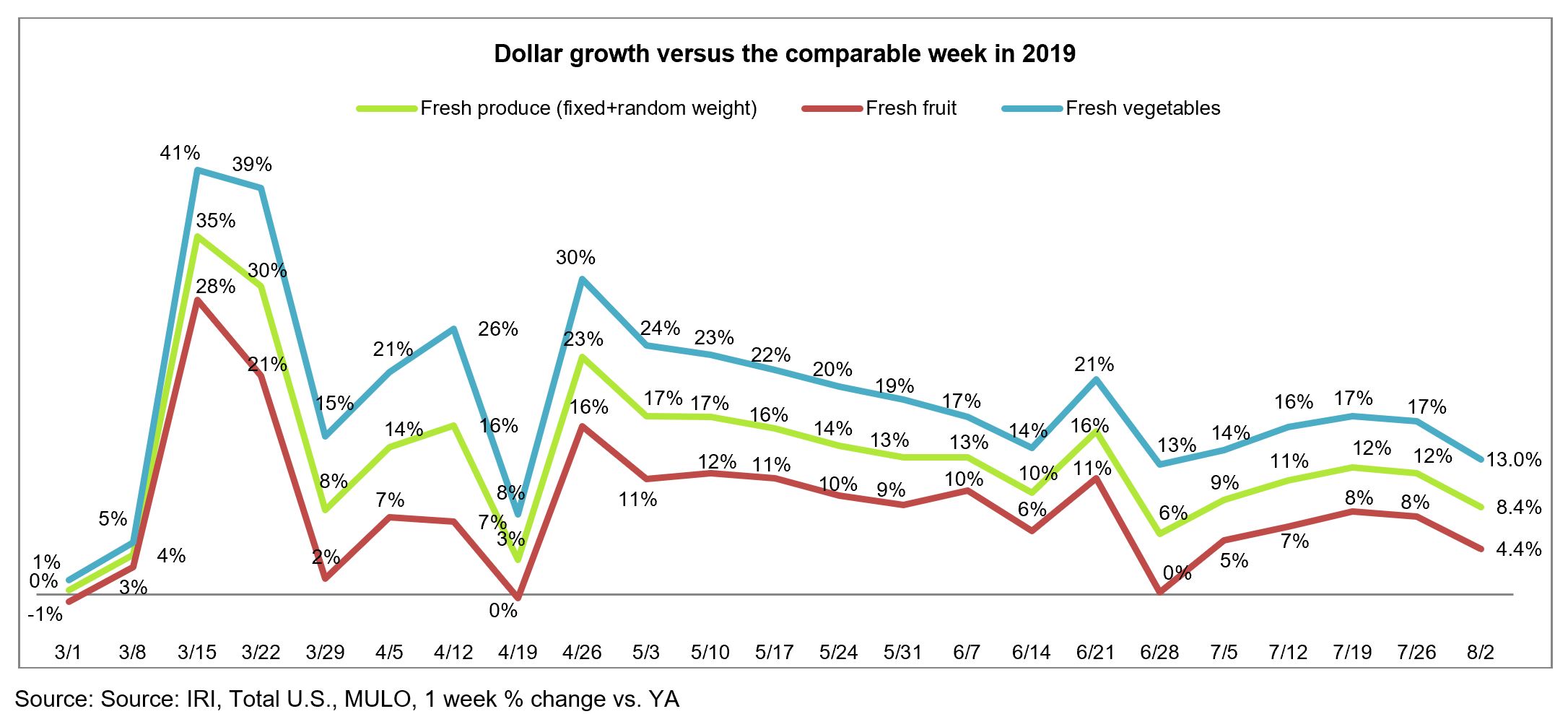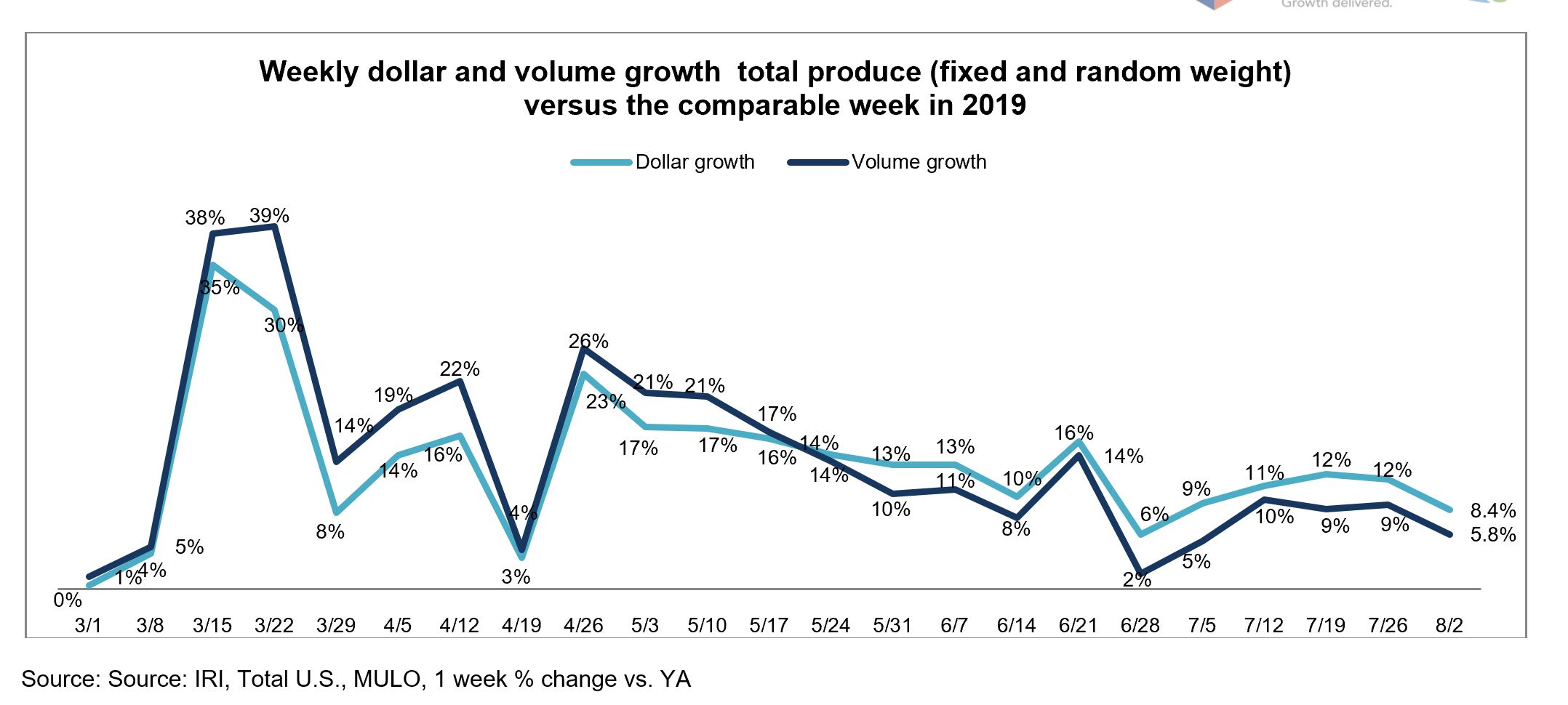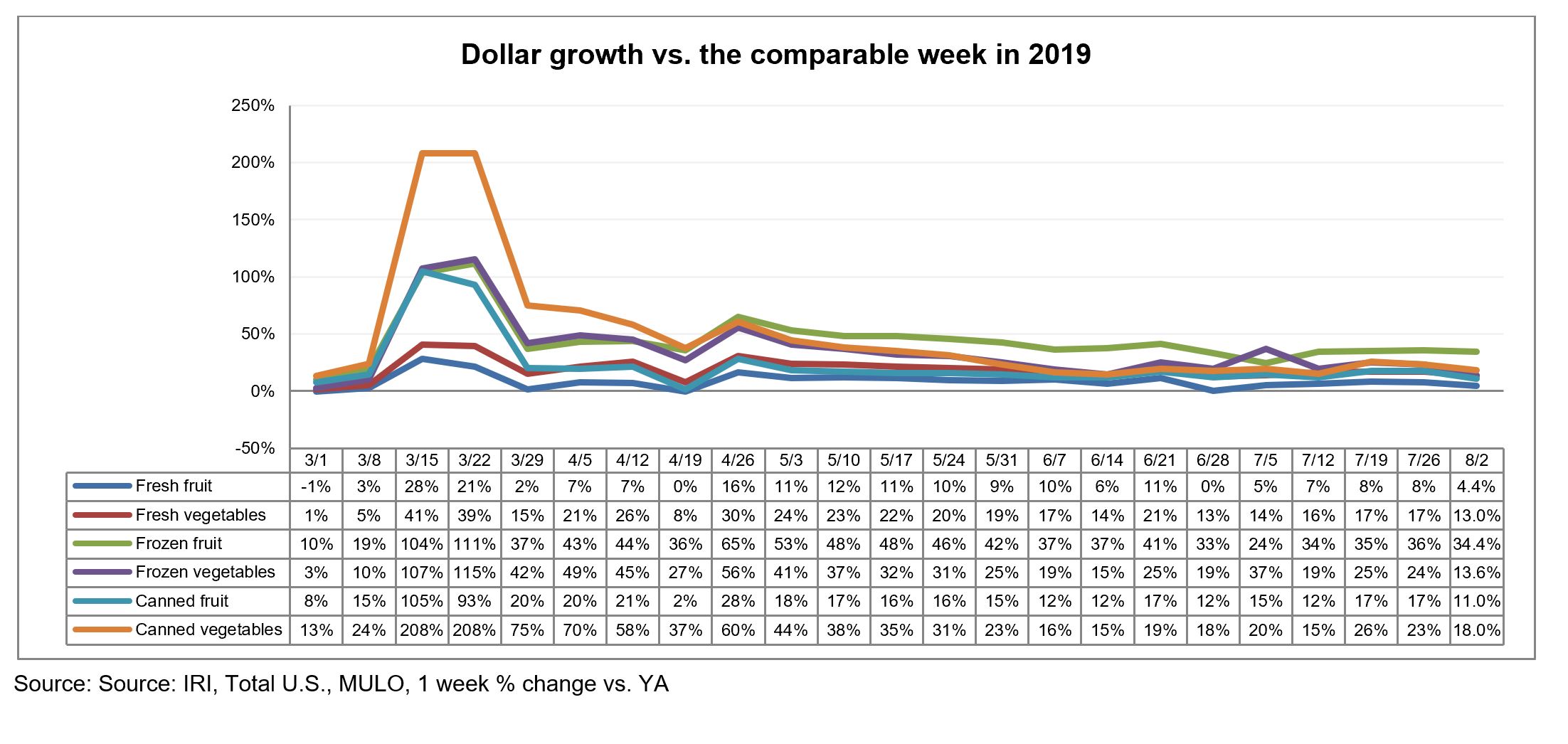Editor’s note: Click charts to enlarge.
Consumer concern over COVID-19 remains high but stable, with 57 percent being extremely concerned, according to wave 16 of the IRI shopper sentiment survey series.
Economic pressure, however, is mounting. Thirty percent of shoppers say they are financially worse off than they were last year and 25 percent indicated they are buying value-size items to save money, up from 20 percent in late May.
Additionally, 65 percent of consumers expect the economic crisis to last at least 12 more months — the highest percentage across all survey waves and near double that of the 37 percent who expected the economy to need a year to recover back in March.
Uncertainty over the unemployment benefit extension may have also been weighing on the numbers this week. Economic pressure tends to have big impacts on grocery shopping, including channel choice, the type of items and quantity bought, the importance of price and promotions and more.
Much like seen the last week of June, the final days of July into early August generated a weaker performance. While CPG and fresh sales continued to track ahead of last year, virtually every department across the store saw lower gains than those seen during the past few weeks. 210 Analytics, IRI and PMA partnered to understand fresh produce sales at retail throughout the pandemic.
The net result for fresh produce was an increase of 8.4 percent over year ago during the week ending August 2 — down about three percentage points from the week prior. Frozen and shelf-stable fruits and vegetables had higher percentage gains but off a smaller base, with particular strength for frozen, at +20.3 percent.
Year-to-date, fresh produce department sales are up 10.9 percent over the same time period in 2019. Frozen fruit and vegetables increased the most, up 27.6 percent year-to-date.
Dollar sales gains total store fruit/vegetables versus year ago
“There are many factors going into the produce at retail sales puzzle right now, with the market growing more complex by the week,” said Joe Watson, VP of Membership and Engagement for the Produce Marketing Association (PMA).
“Consumer concern over the virus remains very high, economic pressure is mounting, hurricane Isaias left several hundred thousand households without power all along the eastern seaboard and all the while consumers are struggling with meal planning and new recipe ideas. All this affects fresh produce sales at retail, some positively, some negatively.”
Fresh Produce
Fresh produce generated $1.34 billion in sales the week ending August 2 — an additional $104 million in fresh produce sales over the prior year. Growth rates for both vegetables and fruit dropped versus the prior week levels.
Vegetable gains, while 13.0 percent ahead of last year, saw the lowest increase since the start of the pandemic sales patterns in mid March, with the exception of the week ending April 19, which went up against the Easter 2019 sales numbers.
Fruit gains dropped to 4.4 percent. Fruit’s pandemic performance has been a bit more up and down than vegetables, but this too was the lowest gain since the final week of June.
“During the week of August 2, total store trips and total edible trips fell below last year’s levels by 1 percent,” said Watson. “With fruit being more affected by impulse sales, the number of weekly store visits is very important to the sales performance for fruit.”
“Whether it was the lack of trips, the influence of the last week of the month, the uncertainty surrounding the extension of unemployment benefits, the impact of hurricane, or a combination of all the above, the sales performance across departments was a bit lower this week” said Jonna Parker, Team Lead, Fresh for IRI.
“I expect the coming weeks to be very telling for what the rest of the year may hold in terms of everyday demand. Back-to-school season is around the corner for several states, and our weekly survey found that half of parents with children ages six to twelve are now expecting their children to partake in virtual education (50 percent), with an additional 15 percent expecting mixed virtual and in-person education. Only 19 percent of parents expect their younger kids to go back face-to-face. Parents of teenagers expect 24 percent to go back in person, with 42 percent expecting virtual education only and 19 percent a mixed virtual and in-person system. This will once more completely change year-over-year trending, as many more meal occasions for these students will remain at-home.”
Fresh Share
After falling to as low as 70 percent of total fruit and vegetable dollars across temperature zones, the fresh share had made a full comeback to its typical 84 percent during Independence Day week. However, as COVID-19 cases started to rise again, the fresh share has fallen back down to 82 percent, with above-average strength for frozen fruit and vegetable sales.
“The fresh share of total produce dollars remained at 82 percent,” said Parker. “Up and down the eastern seaboard, the hurricane may have impacted fresh sales and generally speaking, we see more focus on shelf life again, much like in March when people were in the their stock-up mindset.”
Fresh Produce Dollars versus Volume
Dollar gains continued to track ahead of volume gains ever the week of May 24. And while down from prior weeks, both dollars and volume sit comfortably ahead of 2019 levels. Overall, dollars tracked 2.6 percentage points ahead of volume, however, the overall view is a bit misleading with many areas seeing double-digit inflation or deflation.
Both fruit and vegetables saw dollar sales gains track ahead of volume gains, by about two percentage points. Fruit volume gained 2.4 percent over the same week last year, showing demand is up but not quite keeping pace with other foods. Vegetable volume growth remained in double digits during the week ending August 2.
While overall inflation may be mild, supply and demand continue to be out of synch in many areas, causing double digit gaps in dollar gains and volume gains in either direction. Ample supply is driving double-digit deflation for items such as avocados, pineapples and grapes.
On the other hand, dollar gains are far outpacing volume due to double-digit inflation for items such as cherries, mangoes, berries and corn.
Absolute Dollar Gains
The top 10 in absolute dollar gains completely changed from the week prior yet again. Taking over from lettuce, tomatoes contributed $10.5 million in new sales versus year ago as the number one in absolute dollar gains. Berries was second with a gain of $10 million, boosted by 15.8 percent inflation.
“The top 10 in absolute dollar gains shows how much sales contributions can change each week,” said Watson. “Seven out of the 10 items are vegetables, which explains the above-average strength in performance versus fruit that we have seen throughout the pandemic. Oranges, the pandemic consumer favorite, made it back into the top 10 on weaker melon gains, that dropped out of the top 10.”
Fresh Fruit
“In fruit, berries and melons dominated total weekly sales in early August,” said Watson.
“One important reason why fruit sales are falling behind vegetables each week is that some of the largest categories are not gaining aggressively or even losing ground,” said Watson.
“In other cases, sales are going up against a very high 2019 bar. For instance, with melon sales in their high season, gains were just 1.2 percent versus year ago, but sales actually increased versus the week prior. Lastly, dollar gains and losses are heavily impacted by deflation and inflation in the current marketplace.”
During the week of August 2, double-digit gains in the top 10 sellers were reserved for cherries and tangerines. Oranges had the highest gains of all fruits, at +29.4 percent, but fell outside the top 10 in biggest sellers. Sales of apples, grapes and avocados tracked in negative territory versus year ago.
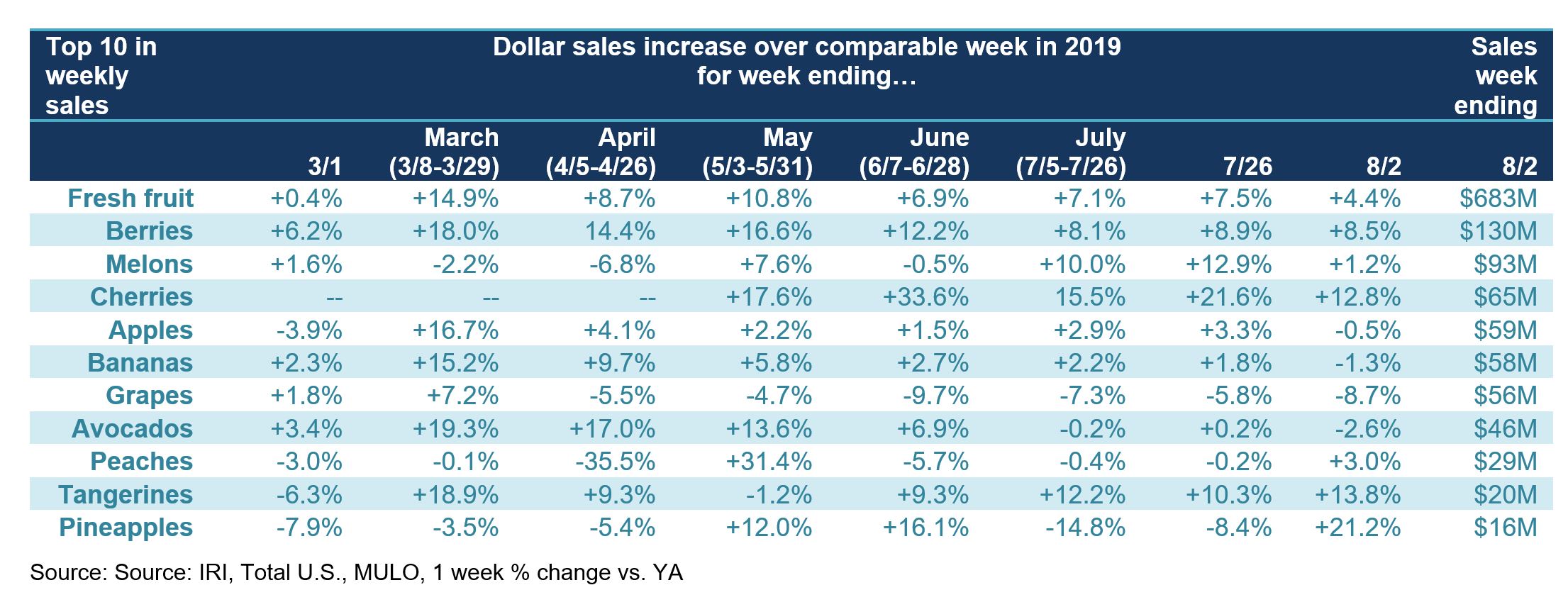


Fresh Vegetables
“While in fruit sales gains were a mix of double-digit, single digit and negative growth, all top 10 vegetables increased in dollar sales versus year ago and seven in 10 did so with double-digit gains,” said Watson.
The order and items in the top 10 sellers was unchanged from last year, with the highest gains going to corn and peppers. Lettuce is the dominant seller, more than twice the size of number two, tomatoes, yet up 6.4 percent versus the same week year ago.
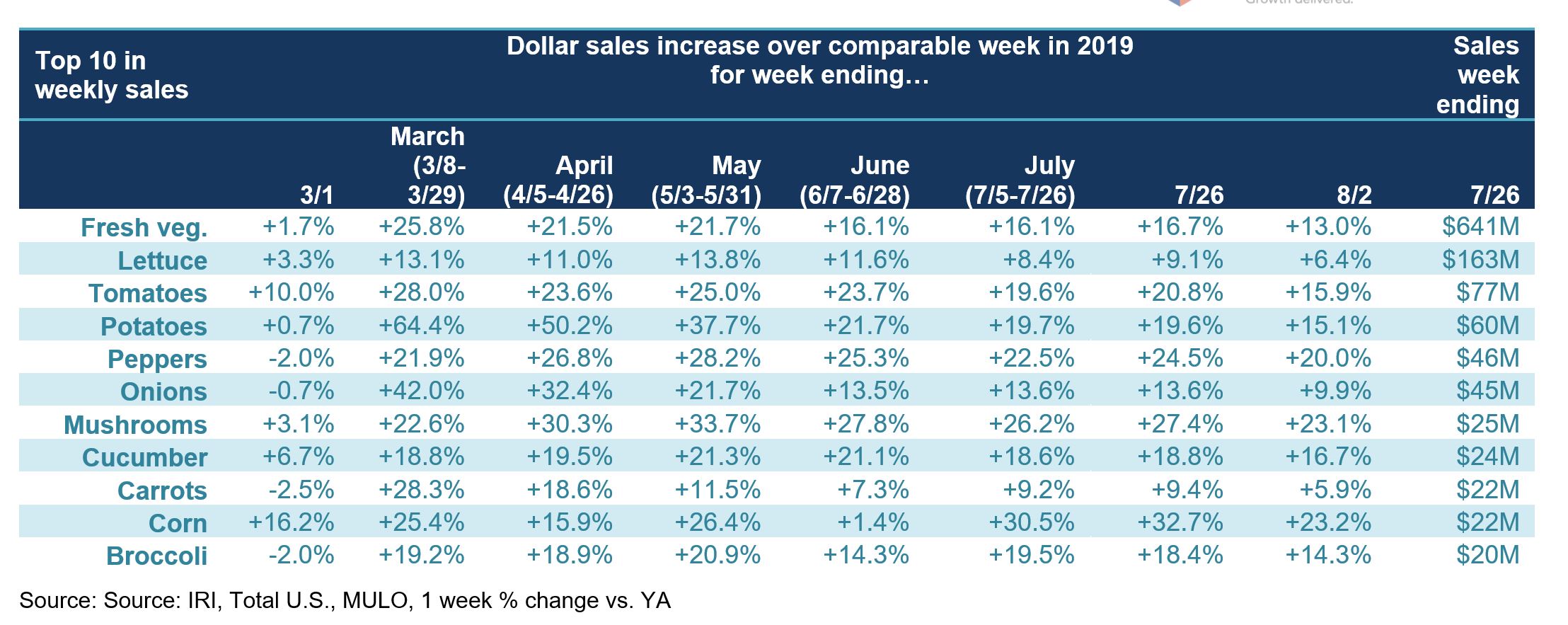


Dollar gains for fresh cut salad dropped to single digits, at +7.6 percent. Volume sales increased 5.2 percent.
Fresh Versus Frozen and Shelf-Stable Fruits and Vegetables
All temperature states of fruit and vegetables had double-digit gains during the week of August 2, with the exception of fresh fruit. Frozen fruit had particularly high gains this week, at +34.4 percent. The continued strength of frozen fruits and vegetables goes hand-in-hand with strong frozen foods performance overall.
Perimeter Performance
The fresh perimeter performance equaled that of total store, but center store edible sales once more outpaced both during the week of August 2. The fresh perimeter gain of +8.5 percent was driven by strong meat and produce sales. Produce’s performance was just a little below the fresh average. Total deli, which encompasses deli cheese, meat and prepared foods, remained pressured, due to heightened pressure on the foodservice offering.
What’s Next?
This was the fourth of eight non-holiday weeks between Independence Day and Labor Day in which everyday demand alone has to drive growth. There is continued uncertainty of unemployment benefits, high concern over COVID-19, important developments in back-to-school decisions and additionally, fresh produce sales for the second week of August may be impacted by the effects of hurricane Isaias with many consumers still without power in affected areas.
Please recognize the continued dedication of the entire grocery and produce supply chains, from farm to retailer, on keeping the produce supply flowing during these unprecedented times. #produce #joyoffresh #SupermarketSuperHeroes. 210 Analytics and IRI will continue to provide weekly updates as sales trends develop, made possible by PMA. We encourage you to contact Joe Watson, PMA’s Vice President of Membership and Engagement, at jwatson@pma.com with any questions or concerns.


